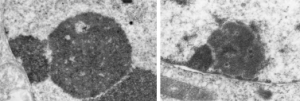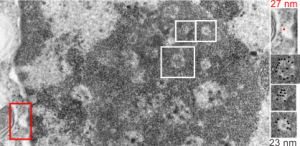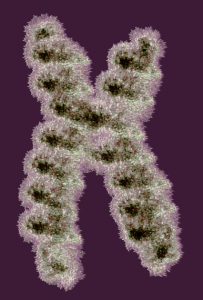 Here are portions of two nucleoli, which just upon casual observation look like they are throwing up some granular components onto the inner nuclear membrane (particularly the image on the right). haha. There are many instances where a physical force appears to be exerted on the constituents of the cell (in this case the nucleus), I can mention two off hand, that is the bending-stretching-pulling look of mitochondria as they swerve over to become attached in some unknown respect to the intermediate filaments of the desmosome, and similarly swerve to the outer nuclear pore filaments to connect there as well. These motions in space have to have significance (at least in my own mind it would be silly to ignore them). At this moment in time I cannot tell you what this means, but one at least seems to be centered over a nuclear pore, the other, maybe a pore would be found out of the section.
Here are portions of two nucleoli, which just upon casual observation look like they are throwing up some granular components onto the inner nuclear membrane (particularly the image on the right). haha. There are many instances where a physical force appears to be exerted on the constituents of the cell (in this case the nucleus), I can mention two off hand, that is the bending-stretching-pulling look of mitochondria as they swerve over to become attached in some unknown respect to the intermediate filaments of the desmosome, and similarly swerve to the outer nuclear pore filaments to connect there as well. These motions in space have to have significance (at least in my own mind it would be silly to ignore them). At this moment in time I cannot tell you what this means, but one at least seems to be centered over a nuclear pore, the other, maybe a pore would be found out of the section.

